IndieWire reached out to the cinematographers whose films are in awards contention and among the most critically acclaimed films of the year to find out which cameras and lenses they used and, more importantly, why these were the right tools to create the visual language of their respective films.
All films are listed alphabetically by title.
“Ammonite”
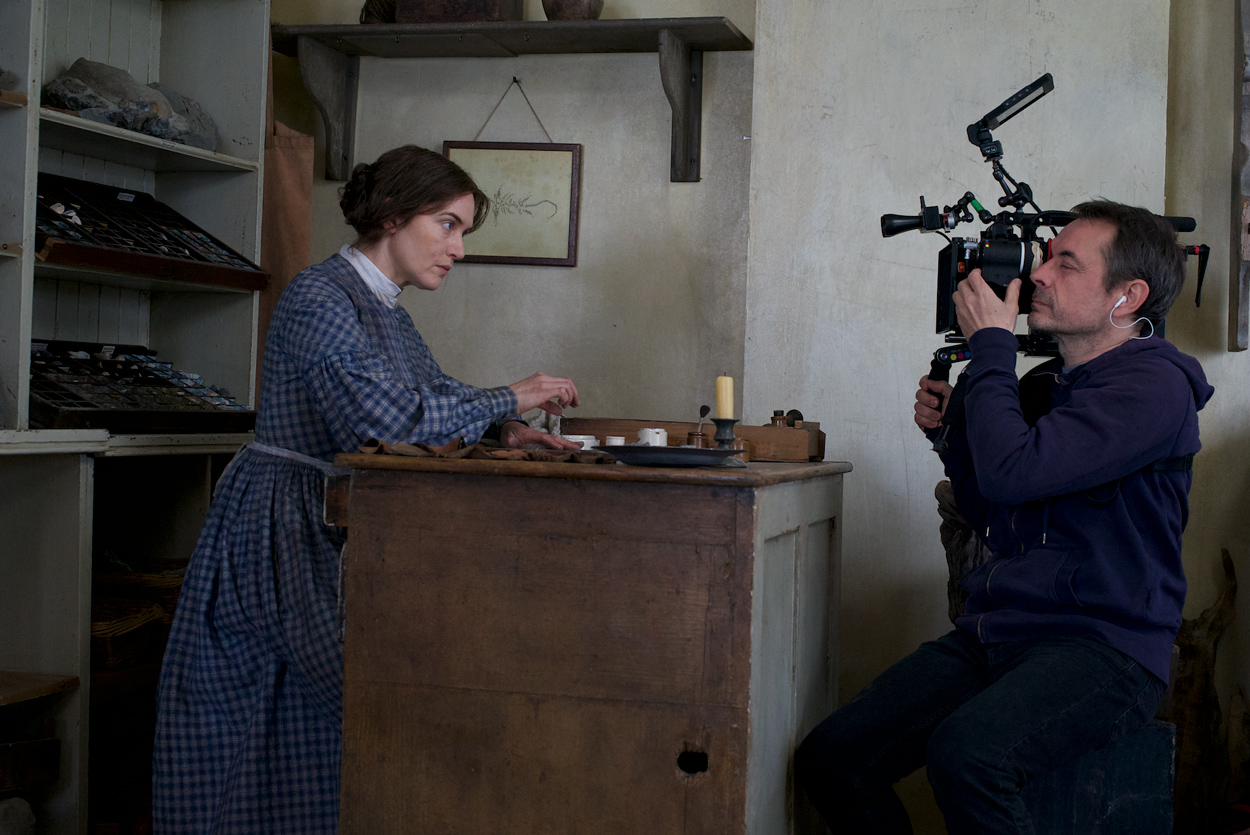
“Ammonite” DP Stéphane Fontaine with actress Kate Winslet
NEON
Dir: Francis Lee, DoP: Stéphane Fontaine
Format: Redcode Raw 7K and 8K
Camera: Red Monstro
Lens: Canon K35
Fontaine: From my very first conversations with Francis Lee, it was quite obvious that our main characters were a bit reluctant to express their emotions with words, and that the camera had to find a way to capture their feelings without being intrusive. Using a camera with a big sensor such as the Red Monstro allowed us to photograph them as if using a medium-format still camera, focusing on their faces and also giving a painterly quality to the background.
A very soft, but contrasty light combined with a set of old-glass Canon K35 lenses added to the delicacy of our approach. Moody interiors lit by candles were a great counterpoint to the windy Dorset beaches in winter. This apparent austerity combined with a slow-paced storytelling makes for a rather unique experience in terms of acting performances.
“Another Round”
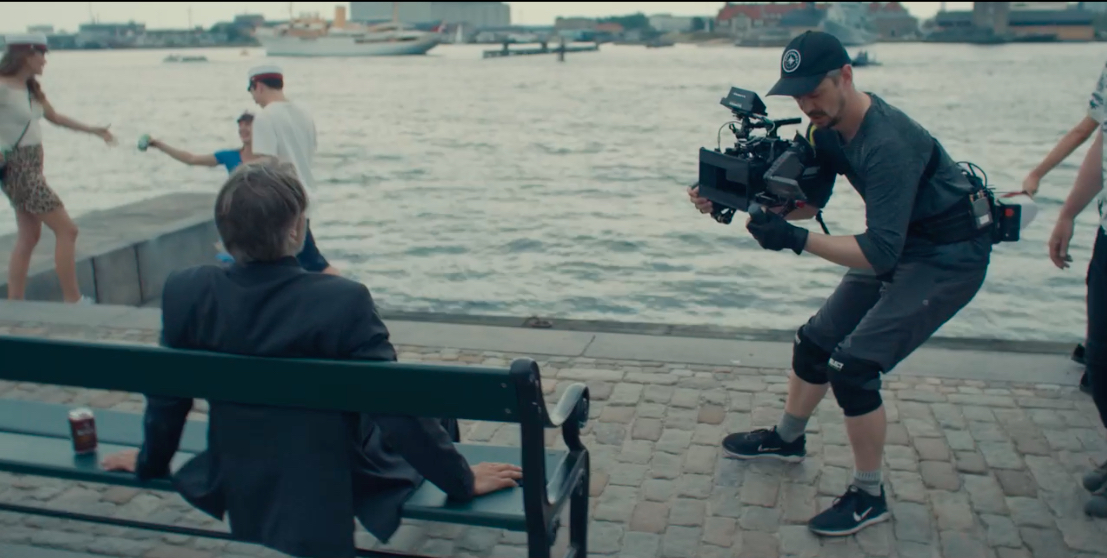
“Another Round” cinematographer Sturla Brandth Grøvlen
courtesy of filmmaker
Dir: Thomas Vinterberg, DoP: Sturla Brandth Grøvlen
Format: 3.2K ProRes 4444 XQ
Camera: Arri Alexa Mini
Lens: Canon K35 (rehoused by P+S Technik)
Grøvlen: We wanted the film to feel playful, human and honest, and we approached the shooting style in the same way. The whole film is shot handheld and we lit for 360 degrees, which meant that we could explore every scene with a lot of freedom. It was an intuitive process where the handheld camera would react differently in every take, depending on what felt right. For this the Alexa Mini is great. It not only produces amazing images, but it is lightweight once you strip it down to the bare minimum. I wore the battery and other accessories in a belt and that made me able to move very freely.
The Canon K35 lenses have a characteristic that I really love, they are fairly lightweight and fast, quite soft and easy to work with. We wanted an imperfect image, that slowly became more crisp and clear as the characters’ alcohol level rise. For some of the drinking sequences I used a close focus diopter to get an extreme low depth of field, that hopefully helped the feeling that the characters become more in touch with themselves and care less about their surroundings.
“Cherry”
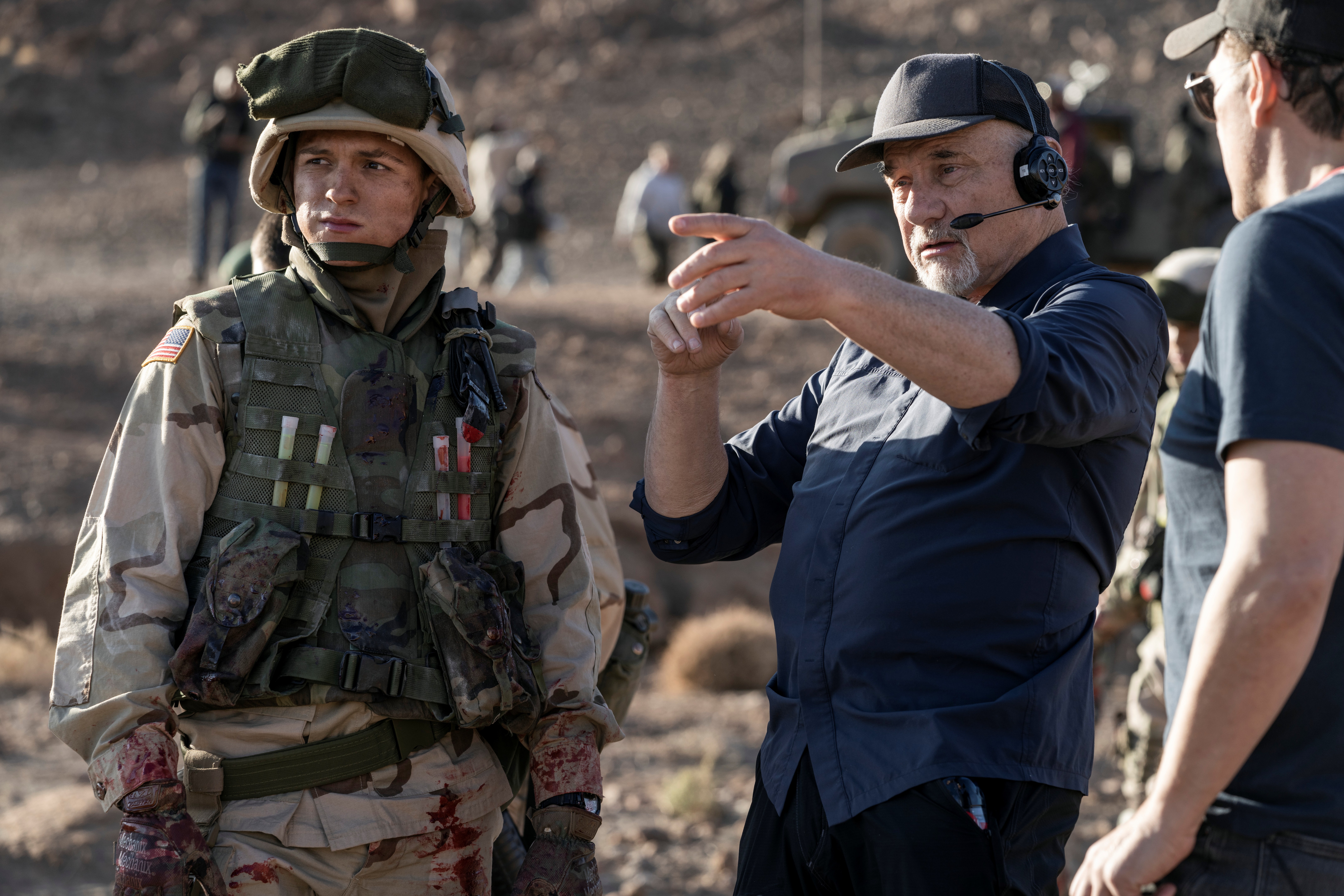
“Cherry” cinematographer Newton Thomas Sigel with actor Tom Holland
Apple
Dir: Joe Russo, Anthony Russo, DoP: Newton Thomas Sigel
Format: 4K 17×9 for Anamorphic, 6k 3:2 for Spherical. 2.39:1, 1.66:1 for “Basic Training” sequence
Camera: Sony Venice. 3D Red for IR sequence, with Baltar lenses. Todd AO Anamorphic Lenses, with some Hawk classic-X. Sigma 14mm Spherical for “Basic Training,” Leica M0.8 for Iraq sequence. Some 55mm Petzval and Arri Swing/Tilt
Sigel: “Cherry” is a story told in chapters, and each one has its distinct look. The bulk of the film was done with the Todd AO anamorphic lenses. Early on this provides a soft, romantic look when Cherry falls in love.
When he enlists and goes to Basic Training, the look shifts to a 14mm spherical Sigma lense and the walls close in to a 1.66 aspect ratio, signifying how his choice has just closed his world around him. The aspect ratio opens back to 2.39 when Cherry goes to Iraq and experiences the horrors of war. This section is also spherical, and was done with the Leica M still lenses — a very classic documentary look.
On Cherry’s return home we return to the Todd AO, but little by little the look is less romantic, darker and colder as he sinks into the world of drug addiction. The epilogue to our story, Cherry in prison, is all done with the Hawk classic-X Anamorphic lenses.
“Da 5 Bloods”
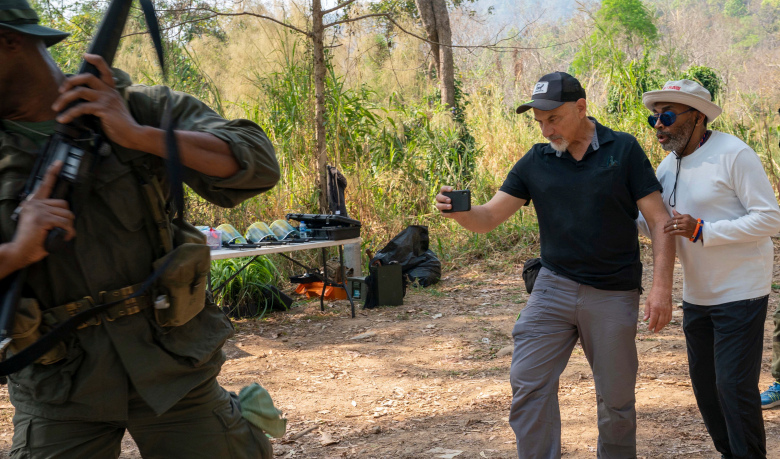
“Five Da Bloods” cinematographer Newton Thomas Sigel with director Spike Lee
Netflix
Dir: Spike Lee, DoP: Newton Thomas Sigel
Format: Arri Raw, Kodak 16mm Reversal 7294. 2.39:1, 1.85:1, and 1.33:1
Camera: Arri Alexa LF, Alexa Mini, Arri 416
Lens: Jungle Sequence: DNA LF Primes. Ho Chi Minh City Sequence: Angeniuex Ez 1 & 2 Zooms. 16mm Sequences: Zeiss Primes – 9.5mm, 12mm, 16mm, 25mm, 32mm, 75mm
Sigel: “Da 5 Bloods” story begins (after an archival footage sequence) in modern-day Ho Chi Minh City. It is a bustling metropolis and we chose to shoot Arri Large Format, with modern Angenieux zooms, and a 2.39:1 aspect ratio. This gave the city a very shiny, contemporary look. Forward thinking. But the Bloods’ journey is taking them into the past, so when they hit the jungle, in search of Norman’s remains, we switched to Alexa Minis at 2K, but used a purpose built set of DNA LF lenses, for a softer, less snappy look. The aspect ratio changed as well, to 1.85:1, but rather than close the frame in on the sides, it opens up top and bottom, as if the jungle is swallowing them whole.
When the narrative shifts back to the War in Vietnam, the aspect ratio shifts again to 1.33:1 — the same way America watched it on television. We shot 16mm Ektachrome reversal, mostly hand held, and developed the film as reversal. Spike embraced the idea of telling this part of our story in the same manner as a newsreel cameraperson of the period would. Vietnam was the first war that played out on television.
“Emma”
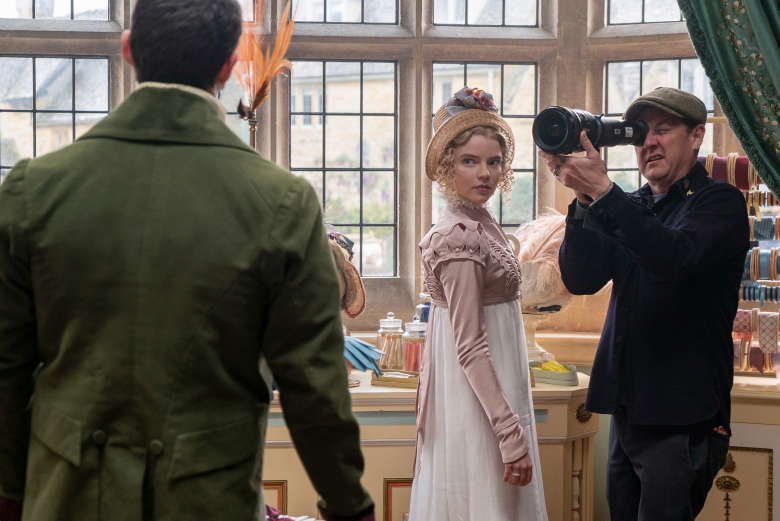
“Emma” cinematographer Christopher Blauvelt with actress Anya Taylor-Joy
Liam Daniel / Focus Features
Dir: Autumn DeWilde, DoP: Christopher Blauvelt
Format: Large Format, full frame, Arri Raw, Aspect Ratio 1.78:1 (16×9)
Camera: Arri Alexa LF
Lens: Arri signature primes
Blauvelt: Autumn, being in England a few months before me, had a lot of information to share. We started with her collection of reference materials that would range from films, photographs and paintings from the time, music from the era as well as music she used as inspiration. We spent time looking for castles and landscapes to serve our story, which we would later use to shoot extensive camera tests. We tested 35mm film and digital cameras with many different lenses, filter combinations, ASA’s, and processes.
After a few weeks of testing, and honing in on images Autumn liked, we took it into the theater to really scrutinize things. With Autumn being a photographer herself the way we collaborate can be really intense and when we found our recipe it was a beautiful moment! In the end, we found that the scope and scale of the large format Alexa was the best way to honor our timeframe and fairytale style. The main objective was to have a style that accentuated the colors and textures in a way that made things feel like “dessert.”
“The Father”
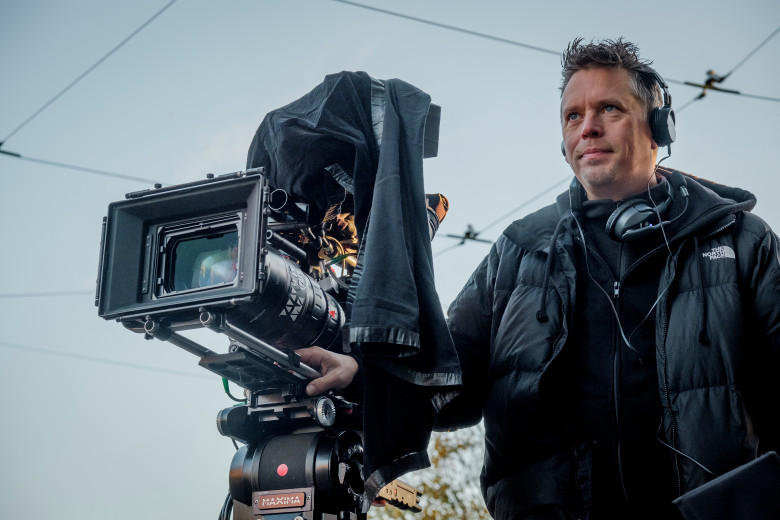
“The Father” cinematographer Ben Smithard
Jaap Buitendijk
Dir: Florian Zeller, DoP: Ben Smithard
Format: Sony 6K RAW X-OCN
Camera: Sony Venice
Lens: Zeiss Supreme
Smithard: The Sony Venice is a great camera, versatile with a huge amount of attributes that make my life as a cinematographer much easier. On a feature like ours with great actors like Anthony Hopkins, Olivia Colman, Rufus Sewell, and Olivia Williams, I was looking for a Camera system that recorded faces as I saw them in real life. The Venice has great colour rendition, and a brilliant contrast range, and it’s super easy to use.
I wanted to concentrate on the performances and my lighting, it’s that kind of film, the film I generally shoot. Also I had just finished shooting “Downton Abbey” on the Sony Venice, so it made sense to use it on “The Father.” The camera is just a tool. I spend lots of time thinking about how I’m going to use the camera, and what camera to use whilst in prep, then I just want to completely forget about it when I’m shooting, and just shoot the film. Once shooting, I’m only really interested in what is in front of the camera.
“First Cow”
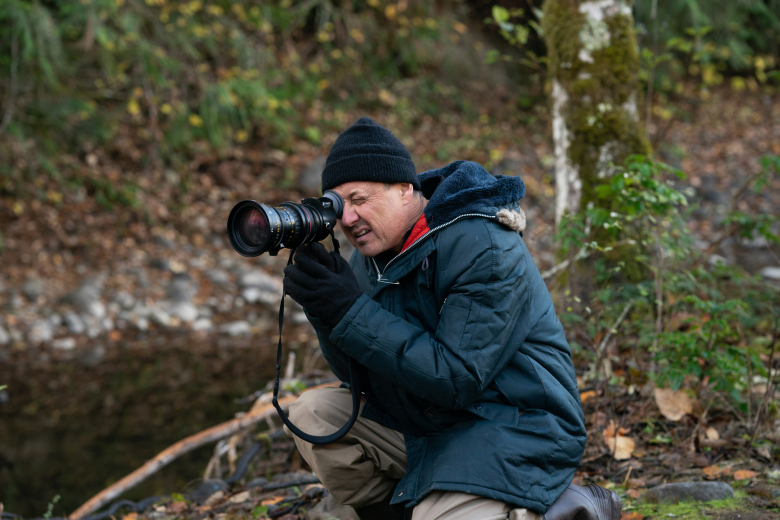
“First Cow” cinematographer Christopher Blauvelt
Allyson Riggs
Dir: Kelly Reichardt, DoP: Christopher Blauvelt
Format: Arriraw open gate 3.4k 1.33 aspect
Camera: Arri alex mini
Lens: Cooke series 2 panchros
Blauvelt: We spent a month testing different cameras and lenses in the environments we were going to shoot. A huge part of finding the right combination of camera, lenses, filters, and LUTs came from the challenge of shooting day for night. Kelly had given me this task a year earlier with references from a different era of filmmaking. I would borrow cameras from Michael (Koerner Camera) in Portland, Oregon, with Jordan Green (friend/camera intern) and take every chance we could to go out into the forests to shoot tests and create a catalog of imagery with every exposure, lens, filter, and ASA, and as many atmospheric examples as we could get.
When DIT Sean Goller arrived two weeks before shooting, we took over a room in this beautiful Victorian house (where we stayed) and put the science to it. Every evening after scouting we’d screen what Sean had worked on and refined it the next day. We got the base look we liked for the film, but day for night was the hardest element of this process to crack. It was almost two days until shooting, when we had a breakthrough (in the wee hours of the night) and we screened it in the theater for Kelly the next day. Kelly watched with laser focus — as always, I was terrified to let her down — and she turned to me, stood up and hugged me! We did it! And I am still very proud of this team effort. Watching the film so effortlessly move from night for night into day for night is a magical experience for me to this day.
“The Glorias”
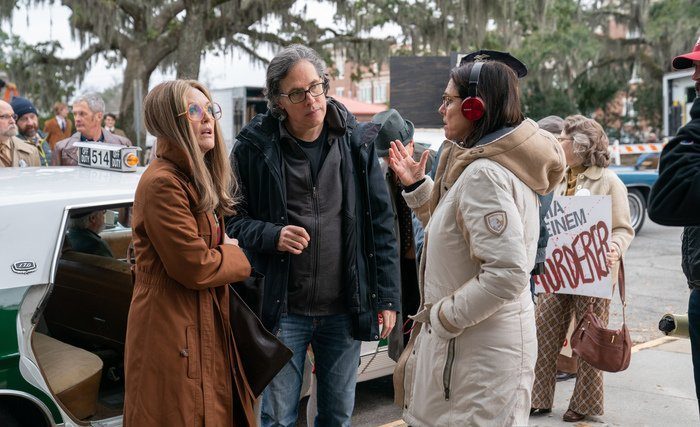
“The Glorias” cinematographer Rodrigo Prieto with director Julia Taymor and actress Julianne Moore
Roadside
Dir: Julie Taymor, DoP: Rodrigo Prieto
Format: RAW/X-OCN with AXS-R7
Camera: Sony Venice
Lens: H Series spherical lenses and Primo Zooms
Prieto: This is a film about the journey of Gloria Steinem through her life on the road, facing many adversities as well as joy and adventures along the way. The color depth that the Sony Venice offers allowed us to play with different intensities of color as the decades pass and the movie enters her mind in some surreal moments. We cover the gamut, from black and white, through de-saturated colors of her childhood, to the aggressive color of certain settings in the 70’s and dreamlike subjective scenes. The H Series lenses have a vintage quality that, coupled with the large format camera, give the film a sense or period, while immersing the audience in the experience.
“Greyhound”
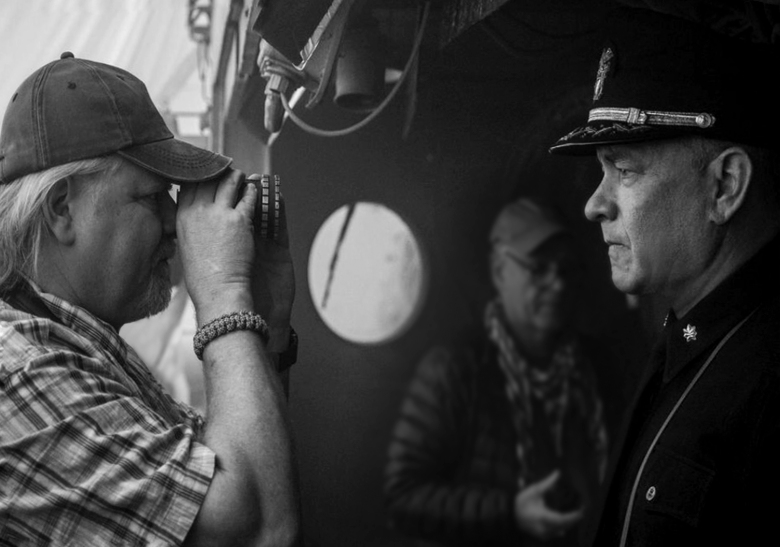
“Greyhound” cinematographer Shelly Johnson with actor Tom Hanks
Apple
Dir: Aaron Schneider, DoP: Shelly Johnson
Format: Panavision DXL 8K RAW
Camera: Panavision Millenium DXL
Lens: Panavision Sphero-65 Lenses
Johnson: The marriage of the more modern DXL Digital camera and far older Sphero-65 lenses manifested in something remarkable when combined with our naturalistic style of studio lighting. The DXL’s power to electronically separate colors, coupled with the lenses ability to meld these colors back together, are two driving components that contributed to the visual authenticity of “Greyhound.” This combination of new and old allowed us to light more naturalistically without the image getting muddy. The large-format spherical lenses accommodated closer shooting with a minimum of distortion. It was important that the audience feel they were placed next to the Captain of a Navy Destroyer during a three-day engagement in the North Atlantic during WWII. The way the light was rendered using these tools helped provide the audience with that perspective.
“Hillbilly Elegy”
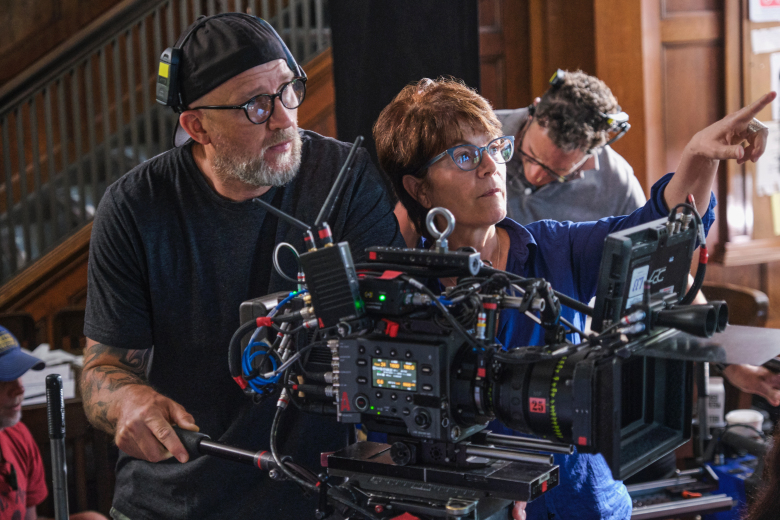
“Hillbilly Elegy” cinematographer Maryse Alberti with camera/Steadicam operator Christopher TJ McGuire
Lacey Terrell//NETFLIX
Dir: Ron Howard, DoP: Maryse Alberti
Format: 4K
Camera: Sony Venice
Lens: Cooke, Zeiss and Hawks
Alberti: The movie is set in three different time periods — late 90s, 2012, and a short trip into the mid 40’s. In my early conversations with Ron Howard we talked about doing all handheld in the 90s with warm rich saturated colors; I used Cooke lenses with the 1/8 black classic soft. For 2012 we stayed with a more neutral tone, steadicam and dolly moves, Zeiss lenses with no filter. The 40s were shot on the Hawks lenses with color shifts from desaturated to full colors done in the DI. We stuck with that approach, and in the DI push further the rich warm saturated color for the 90’s. Working with Ron, the amazing Glenn Close and Amy Adams was one of my best movie adventures.
“Judas and the Black Messiah”
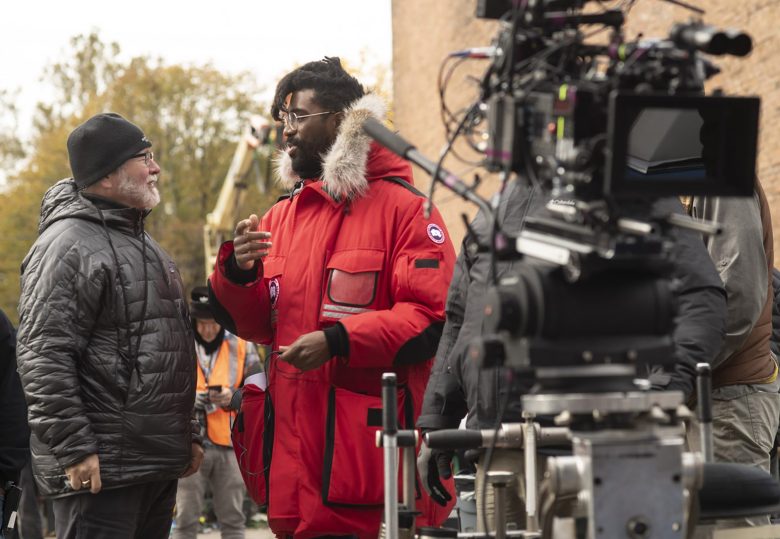
“Judas and the Black Messiah” cinematographer Sean Bobbitt with director Shaka King
Glen Wilson
Dir: Shaka King, DoP: Sean Bobbitt
Format: ArriRaw
Camera: Arri Alexa LF, Alexa LF Mini
Lens: Arri DNA LF lenses
Bobbitt: The Alexa LF and DNA LF lenses were chosen for a number of reasons. The film is not a documentary or a docudrama. We hoped to emphasize that by shooting in a wide screen format. The wide screen format lends itself to strong compositions of groups of people — a recurring image in the film. The shallow focus inherent in the large format cameras can also be used in close ups to isolate the actor from the background with great dramatic effect. The DNA lenses have some characteristics of anamorphic lenses which lend them to a more period feel without having to shoot on anamorphic. The amount and quality of color information in ArriRaw from the LF Camera gave the ability to grade the images without compromise. It also meant that we were able to maintain true and accurate flesh tones for each individual actor.
“Malcolm & Marie”

“Malcolm & Marie” cinematographer Marcell Rév
DOMINIC MILLER/NETFLIX
Dir: Sam Levinson, DoP: Marcell Rév
Format: 35mm B&W Film, Kodak Double-X (5222)
Camera: Arricam LT
Lens: Zeiss Super Speeds
Rév: Shooting on black & white film gave us an opportunity to look at this relationship in a more analytic way and to pay homage to certain Hollywood Classics from the 1960s at the same time. The Double-X stock was introduced in the late 50’s and it still remains the quintessential black & white film stock, so we got to shoot on the same negative as the movies we were referencing while prepping the project. We chose the super speeds to match that classic feel of the material. These are lenses made in the 80s, that still hold a vintage look but are easy to work with and perform well in terms of sharpness. The Arricam LT is my go-to camera when it comes to shooting handheld on film. It has great ergonomics and it’s easy to handle for the camera crew.
“Mank”

“Mank” cinematographer Erik Messerschmidt
Miles Crist/NETFLIX
Dir: David Fincher, DoP: Erik Messerschmidt
Format: 8K 2.2:1 REDCODE RAW
Camera: RED Ranger Helium Monochrome
Lens: LEICA Summilux-C
Messerschmidt: We knew from the onset that we wanted to tell the story of “Mank” in black & white. What was unclear was whether we would originate the film in black & white, or desaturate a color image in post. After testing the color camera against the black & white Red Monochrome there was no comparison. David and I were both very interested in striving towards a platinum print look with a very wide tonal range. The monochrome camera offered that in spades, with tremendous tonal depth and an almost three-dimentionality to it.
There were also a number of classic cinema techniques we wanted to employ to help tell the story of “Mank.” One of these was deep focus photography; a technique Gregg Toland ASC had made famous with his work on “Citizen Kane.” Toland called it “Pan-Focus.” The technique involves stopping the lens down to a very small iris (almost all the way closed) requiring substantially more light but resulting in extreme depth of field; in some cases the entire frame is sharp 18” from the film plane to infinity.
Much of my testing process for “Mank” involved evaluating different lenses to see which would perform best under these conditions. I tested every lens I could get my hands on and the Leica Simmilux-C series lenses far surpassed every other available lenses in sharpness and consistency. We wanted the film to reference, and in some cases pay homage to classic cinema while at the same time apply our own technique and more modern aesthetic. I hope we found a nice balance.
“The Mauritanian”
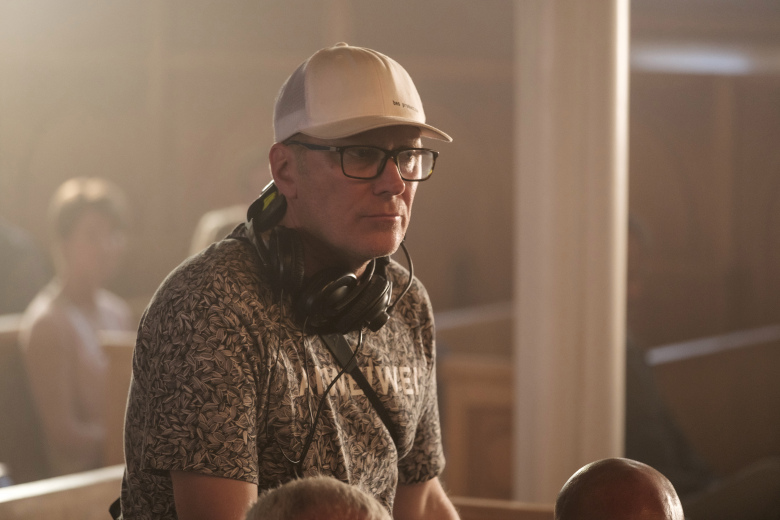
“The Mauritanian” cinematographer Alwin H. Küchler
Graham Bartholomew
Dir: Kevin Macdonald, DoP: Alwin H. Küchler
Format: Sony Venice 4k Sony raw
Camera: Sony Venice and Sony Venice RiAlto mode
Lens: Cooks S 7, Canon K 35, Astro Berlin
Küchler: Our film has a complex time structure, set in three different times in the past and present. Director Kevin Macdonald and I decided to apply varied lenses and formats for the different periods. For our main character’s childhood, we used Astro Berlin lenses from the 1950s. We created the feel of 16mm film by adding film grain. For the earlier scenes in Guantanamo, we used Canon K35 lenses and chose the Academy format. This also served to express the confinement of our protagonist, Mohamedou. His world literally becomes narrower.
For the present, we used the widescreen format with a Cook S7. We used this in combination with the Sony Venice Rialto mode, which made the camera incredibly small, helping us in the very small interrogation rooms and prison cells. One of our main concerns was how to approach the torture scenes as we were very concerned not to make it look like “Torture-Porn.” We drifted in a subjective, dream-like world for which we used self-made filters, diopters for distortion, and swing and tilt lenses.
“The Midnight Sky”
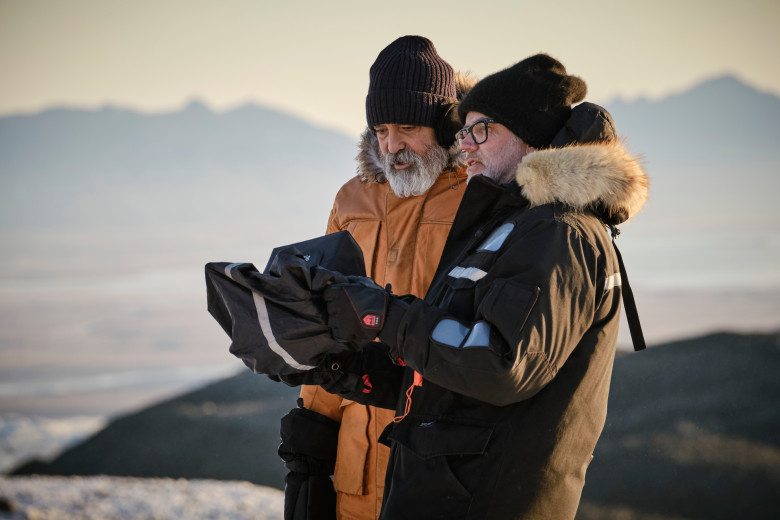
“The Midnight Sky” cinematographer Martin Ruhe with director/actor George Clooney
Philippe Antonello/NETFLIX
Dir: George Clooney, DoP: Martin Ruhe
Format: 65mmm digital in 6K ArriRaw. The film was finished in 4K. Some scenes we shot in 4K ArriRaw.
Camera: Arri Alexa 65, for some scenes we used Alexa Mini LFs
Lens: Arri Prime DNAs, plus the very special Arri 35T and 58T lenses
Ruhe: “The Midnight Sky” is a story of redemption. A spaceship crew on their way back to Earth, but Earth is not answering their call and an old terminally ill man alone in the arctic is trying to contact them. Although we have these big environments, it is a very intimate story about love and hope. The Alexa 65 gave us that scope in outer space and tons of details in our widest arctic shots. But it also gave us an intimacy in the close up shots like no other format can. Also the film was meant to be shown in a limited IMAX version and in cinemas before streaming. Unfortunately not many people saw it like that due to our own isolation by the pandemic.
“Minari”
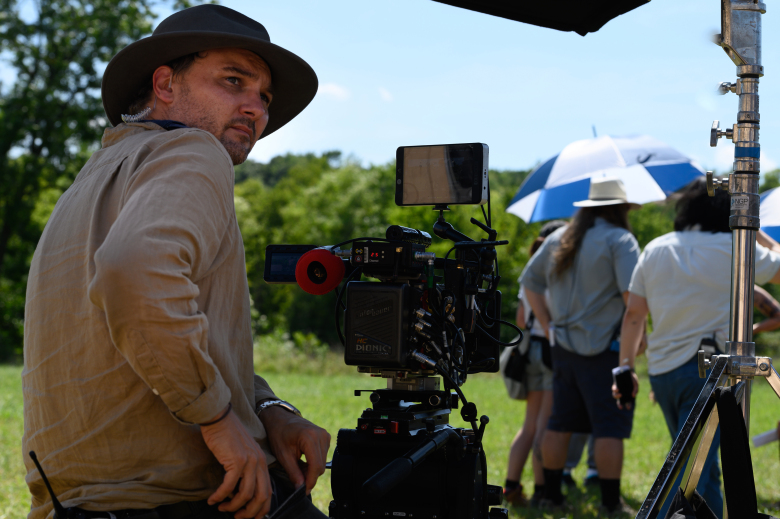
“Minari” cinematographer Lachlan Milne
Melissa Lukenbaugh/A24
Dir: Lee Isaac Chung, DoP: Lachlan Milne
Format: 3.2k pro res 4444xq
Camera: Arri Alexa mini
Lens: Panavision P Vintage lenses
Milne: Almost all of my work these days is on the Arri Alexa. What I needed from a camera on “Minari” was something lightweight with as small a profile to it as possible. Much of the film takes place in the trailer where we couldn’t pull walls, so keeping things small was important. I made my own LUTS after shooting a few tests. The Alexa Mini lets me upload those straight into the camera, so I could base my lighting and exposure ratios on that.
When you’re working with kids, it’s really important to be flexible. I could go handheld in a matter of seconds, which meant that I could help keep the film spontaneous in places where the younger cast would start to improvise. The internal ND’s, in combination with the P Vintage lenses, meant that I could keep the lens free from filtration which is a good trick to avoid actors’ own reflection which is especially good when working with kids. The lenses have a fantastic range between 20 and 40mm, which is where I felt most of the film was going to sit, and the vintage nature of them helped bloom the practical lights I knew I was going to lean on.
“Mulan”
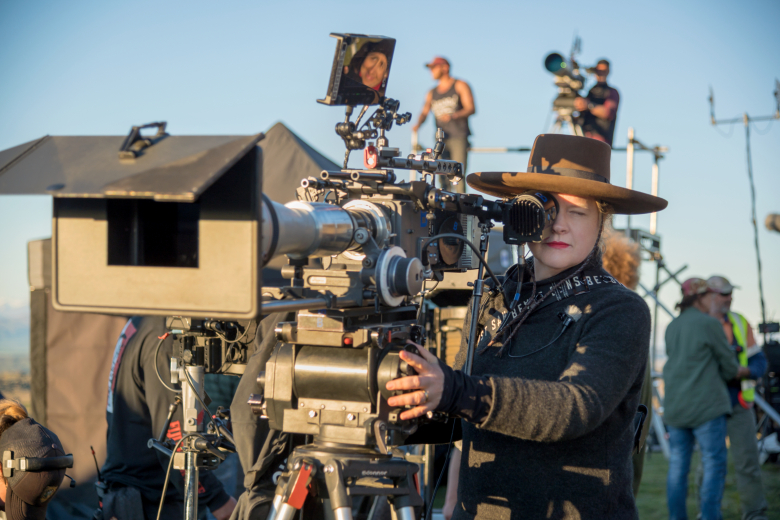
“Mulan” cinematographer Mandy Walker
Jasin Boland/DISNEY
Dir: Niki Caro, DoP: Mandy Walker
Format: 6k Arri Raw
Camera: Arri 65
Lens: Panavision Spheros, Petzval 85mm portrait lens, and Guass lens
Walker: We shot on 65mm because we felt it was a film that needed the epic scale and vistas of landscape, and the intimacy of portraits with the Petzval lens. The guass lens pushed the eye of the audience to the center of the frame to enhance the ‘Chi’ and elite warrior talents of Mulan. The lenses we chose were specifically built for this film to enhance the painterly landscape shots of Mulan’s journey. We also framed Mulan in the centre of the composition and dropped off the focus of the background for the audience to feel like they were with her in the battle scenes.
“The Nest”

“The Nest” cinematographer Matyas Erdely
courtesy of filmmaker
Dir: Sean Durkin, DoP: Matyas Erdely
Format: 35mm Film
Camera: Arricam LT
Lens: Cooke S4, Angenieux 24-290
Erdely: The decision to shoot “The Nest” on film was already made by Sean and the producers before I was even hired, which is a fantastic thing to experience. There was no need to convince anyone why film just looks better and also gave us a very streamlined and super efficient workflow. The film takes place in the ’80s, and in my initial discussions with Sean, we thought exposing the 35mm film specifically to create a lower contrast look would be enough to create the feeling of the era. When did a costume and make-up test in 35mm, and looked at the graded rushes, Sean and I immediately felt that this is it. No need for added trickery.
The film is shot simply. Most of the time a scene is one shot — sometimes more, but always as few as possible. Sean taught me how to use a zoom very creatively and precisely, and we relied on it often. Sometimes we switched to handheld when we felt it was appropriate, but we really limited our filmmaking tools to the essentials. I’m extremely happy with what we were able to achieve.
“Never Rarely Sometimes Always”
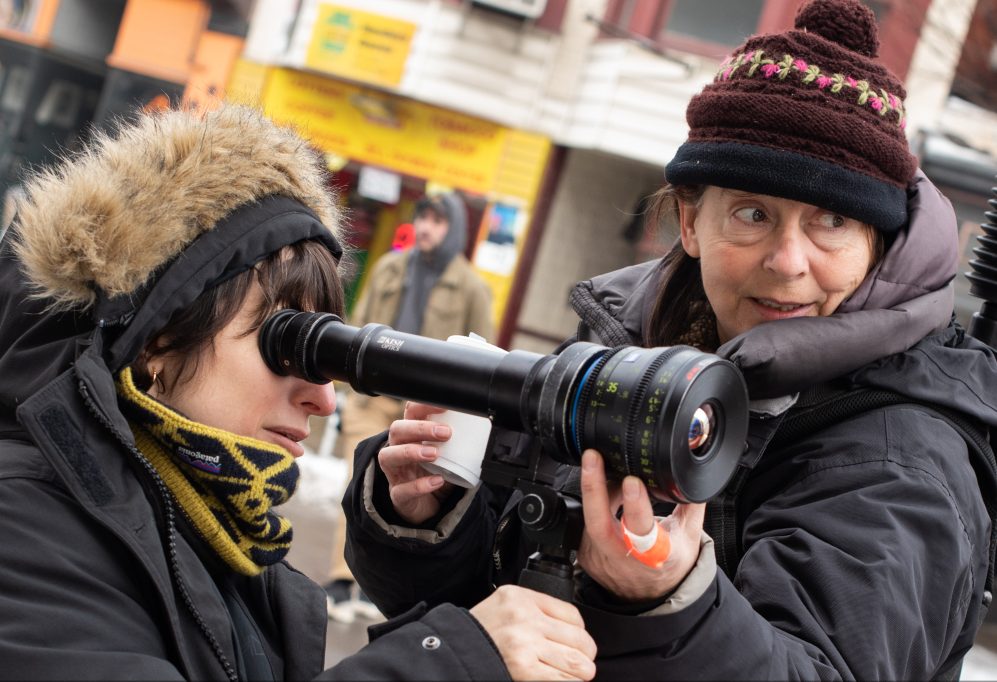
“Never Rarely Sometimes Always” cinematographer Hélène Louvart with director Eliza Hittman, on the left
Focus
Dir: Eliza Hittman, DoP: Hélène Louvart
Format: Super 16 mm
Camera: Arri 416
Lens: Ultra Prime Zeiss
Louvart: The Super 16mm give poetry in the pictures, and it was important for this film not to remain too realistic. This choice brought us to a particular way of filming, and the result is simple skin tone that are naturally soft. Mostly shot with 7219 Kodak, we changed and added some light of course, but always in a natural way. And we continued to follow this choice during the color grading. Keeping as much as we can the feeling of the Super 16mm.
“Nomadland”
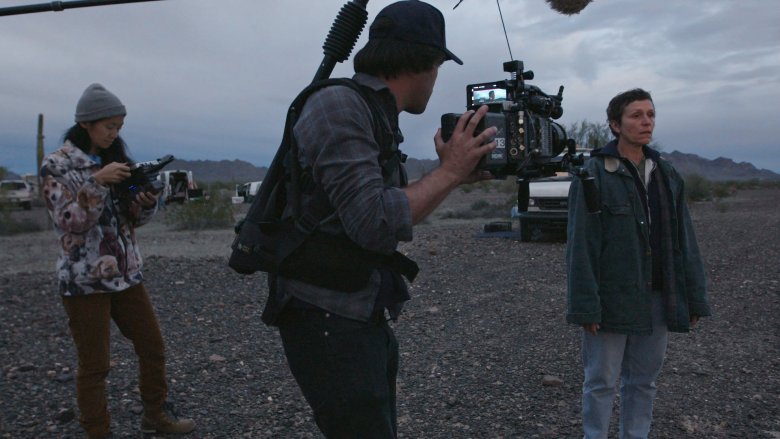
“Nomadland” cinematographer Joshua James Richards with director Chloé Zhao and actress Frances McDormand
Searchlight
Dir: Chloé Zhao, DoP: Joshua James Richards
Format: ArriRaw 2880×1620
Camera: Arri Alexa Mini and Amira, Ronin 2 Gimbal
Format: Ultra Primes
Richards: The main thing when approaching a film with Chloé is to make sure the performances feel as honest and lived-in as possible, so we worked backward from that. The Alexa Mini was the right choice in that regard because you want to be compact and nimble, but you also don’t want to compromise those real human connections with your subjects. Otherwise you feel like an outsider, especially in close-ups where you really hope to have their trust.
There’s a quality to the Ultra Primes that helps with that, too, like you’re not putting too much between the subject and the audience. (We used mostly the 16, 18 and 32mm, which I love.) Besides those moments, we also wanted to convey this feeling of tracking Fern’s journey through these landscapes, which is where putting one Mini on a Ronin 2 gimbal came in handy. We used it almost like a dolly, to carry the audience on a voyage alongside her.
“On the Rocks”
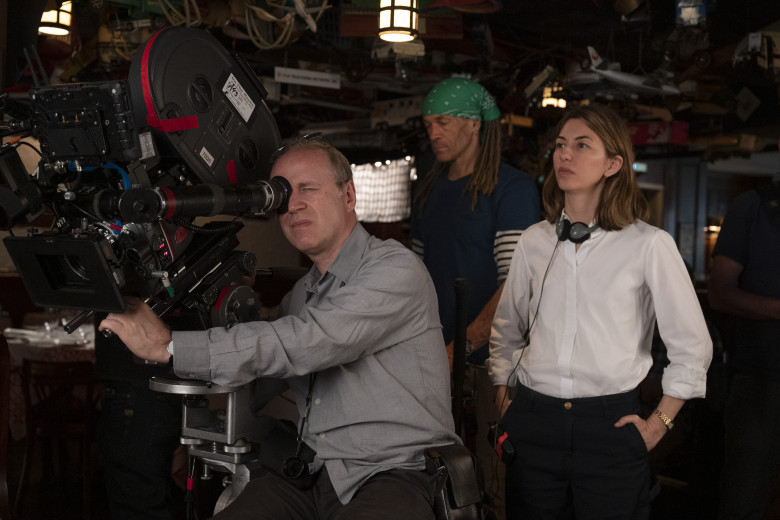
“On the Rocks” cinematographer Philippe Le Sourd with director Sofia Coppola
Apple
Dir: Sofia Coppola, DoP: Philippe Le Sourd
Format: 35mm, (Kodak Vision3 5219, Vision Vision3 5213)
Camera: Arricam Light 3 Perf, 1.85:1 aspect ratio
Lens: Ultra Speed Lens Panavision
Le Sourd: I love the interpretation, challenges, and surprises of film. Film captures skin tones in a very graceful way and the highlights are milkier. They’re also many interesting questions that you have to ask yourself in preparation and pre-lighting. The decision of the film stock can lead to many different visual meanings. I mainly used 5219 in New York, and 5213 for the scenes in Mexico. Shooting on film at night is always more complicated — do I want to relight the street? I did some tests at night and decided to pull the 5219 negative one stop to get more detail in the highlights and in the black. Sofia always wanted to shoot on film, and there were no discussions about it for “On the Rocks.”
As for lenses, we wanted to capture both the nostalgia and modernity of New York and I really liked the softness of the Panavision series. I often shoot at a very shallow depth of field and the 50mm opens at f/1 which helped us a bit on some night exteriors. We mostly used the 40mm throughout the entire film as we felt it was the most natural lens to capture this intimate story.
“One Night In Miami…”
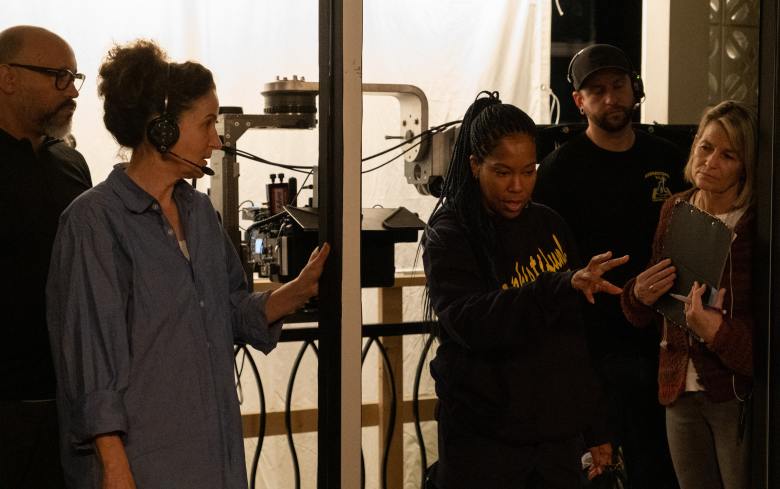
“One Night in Miami…” cinematographer Tami Reiker with director Regina King
Amazon
Dir: Regina King, DoP: Tami Reiker
Format: 6.5K ARRIRAW 2:39 aspect ratio
Camera: Arri Alexa 65
Lens: Prime DNA
Reiker: The film centers on the imagined dialogue of these four iconic Black men. Regina and I wanted an immersive experience, and we wanted the audience to feel like an active member of the conversation. The Alexa 65 gave us the incredible detail and shallow depth of field we were looking for in this film. The fall-off you get with the Alexa 65 allowed us to keep shifting the perspective between the four men. I knew with the Alexa 65 shooting 6.5K I could underexpose in the shadows and not have to worry about noise when it went to 4K.
“Palm Springs”
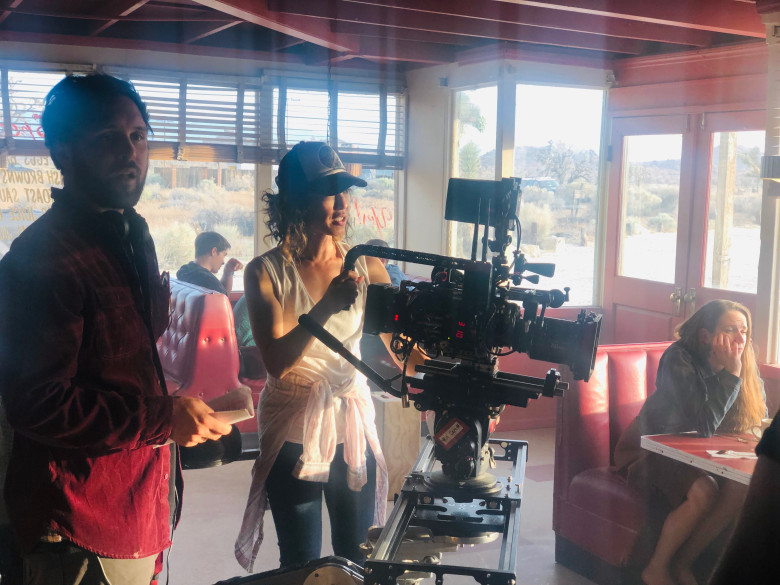
“Palm Springs” cinematographer Quyen Tran
Christopher Willard
Dir: Max Barbakow, DoP: Quyen Tran
Format: 4:3 2.8K 2X ANA (2.39:1 Scope)
Camera: ARRI Alexa Mini
Lens: Panavision T Series Anamorphics
Tran: Since we were shooting in small, practical locations, with multiple company moves I wanted a tight camera profile and close minimum focus. Even though the film has plenty of comedic and absurd moments, it also has a lot of heart, emotion, and pathos. To find the right balance tonally was tricky, so I felt that in choosing the T series anamorphics, which has a very dreamy minimum focus, I could get the camera to an intimate space both physically and emotionally with the actors. The fall off and bokeh is so beautiful, and oftentimes surreal depending on the light sources. As the characters begin to open up to one another, so does the camera work, moving from studio mode to a more free flowing handheld — often times we would run scenes documentary style with no rehearsals.
“Pieces of a Woman”
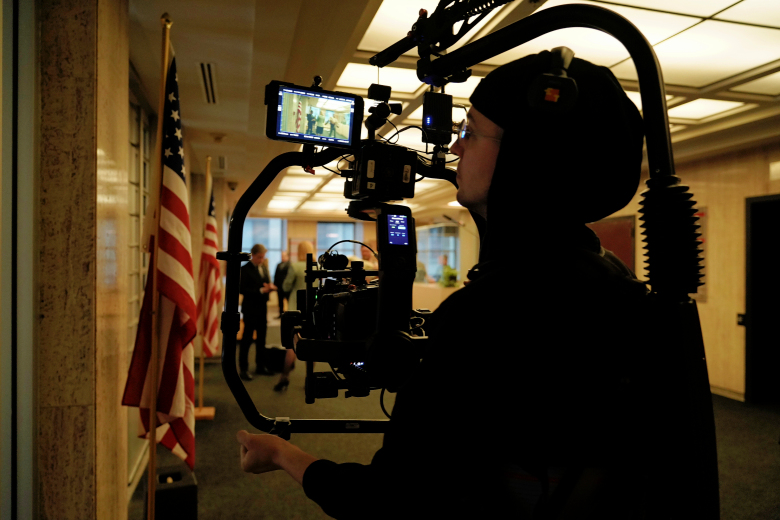
“Pieces of a Woman” cinematographer Benjamin Loeb
Netflix
Dir: Kornél Mundruczó, DoP: Benjamin Loeb
Format: Mixture of ArriRaw and ProRes 4444 XQ
Camera: Arri Alexa Mini on the Ronin 2
Lens: Detuned Panavision PZM and Primo Primes
Loeb: We wanted the film to be rooted in realism and grounded in a feeling that reflected Bresson — but that also stayed true to classic auteur melodrama, in the vein of Fassbinder and Ophuls, just with a human edge. Essentially making it feel as if they were watching a cinema verité through the eyes of a spirit or a soul – perhaps the lost one. This became the backbone to our philosophy behind how and why the camera would move in the manner it did, and the somewhat curious nature of it.
The Ronin 2 gimbal with the Alexa Mini became our workhorse setup for the entirety of the film. It made me flexible in my movement, as well as giving the actors the most flexibility as the floor was theirs to utilize as each set was lit for 360 degrees. Our visual inspiration came from the paintings of Lucian Freud as well as Balthus, and I felt the softness and the tone fit well with the Alexa Mini which became necessary as some of our takes were quite long.
“Promising Young Woman”
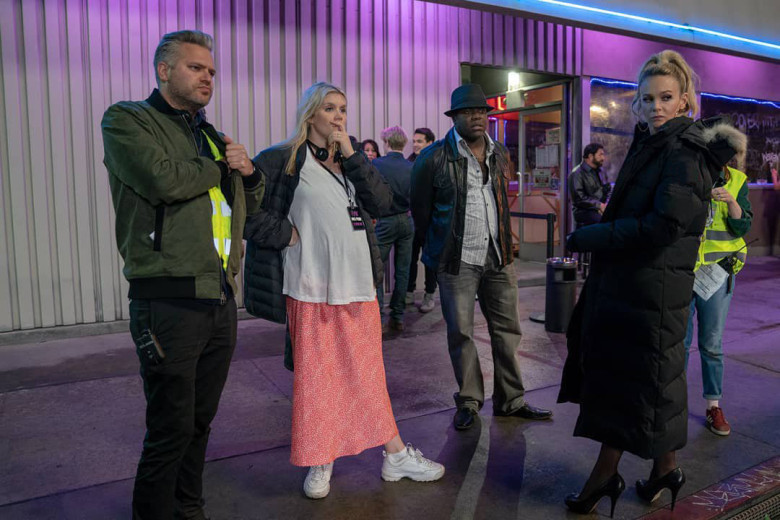
“Promising Young Woman” cinematographer Benjamin Kracun with director Emerald Fennell and actors Sam Richardson and Carey Mulligan
Focus Features
Dir: Emerald Fennell, DoP: Benjamin Kracun
Format: 2.8K ProRes 4444
Camera: Arri Alexa Mini
Lens: Panavision G-Series Anamorphic
Kracun: We chose to shoot on the Alexa Mini with G-Series Anamorphic lenses. First, Emerald and I wanted to create a heightened world, a luscious and seductive one but also dangerous — this is a predatory world where Cassie has to confront a trauma in her past. I love pairing the Alexa with older glass, I knew we wanted to amplify certain colors, but retain a dreamy softer image texture. I’d shot many of my previous films on Alexa and knew how far I could push the camera when needed.
We tested many lenses but ultimately the G-series lenses had the perfect character for us, they contain certain aberrations especially when using the wider lenses and often the edges would slightly blur. The combination of slightly de-tuned G-series and the colorful design of the film was the perfect flavor. The lenses had an imperfection we loved. Using the wide end of the anamorphic lenses and emphasizing the negative space within scenes really helped to amplify our world. A world which feels safe but also out of balance.
“Shirley”
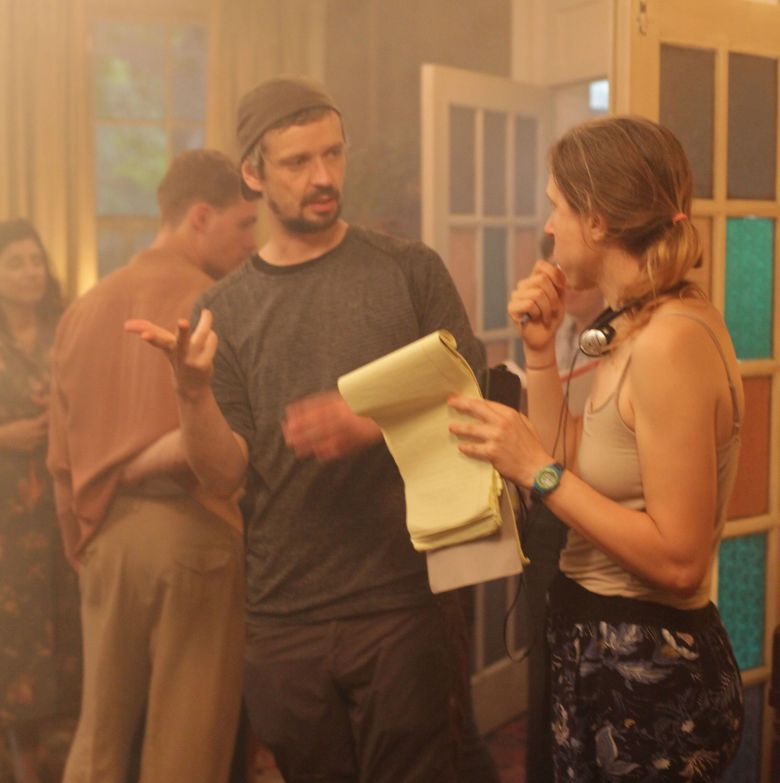
“Shirley” cinematographer Sturla Brandth Grøvlen with director Josephine Decker
Thatcher Keats
Dir: Josephine Decker, DoP: Sturla Brandth Grøvlen
Format: 3.2K ProRes 4444XT
Camera: Arri Alexa MINI
Lens: Bausch&Laumb Super Baltar Primes, Angieneux 24-290 Optimo
Grøvlen: We experimented a lot with visual concepts on “Shirley”, and approached each scene with curiosity and an open mind. So it was important to have tools that didn’t limit our creative process or slow us down. We wanted a very organic and distinct look for Shirley’s house, which we wanted to treat as a character in itself. We tested 35mm film, but in the end we couldn’t afford it. I felt that with the combination of the Arri Alexa Mini and the SuperBaltar lenses we were able to create a look that had the organic feel that was right for the interiors of the house. For the exteriors we wanted a crisper look and ended up going with the Optimo 24-290. We also used a lensbaby for specific scenes to enhance a world which dissolves between fiction and reality.
“Sound of Metal”
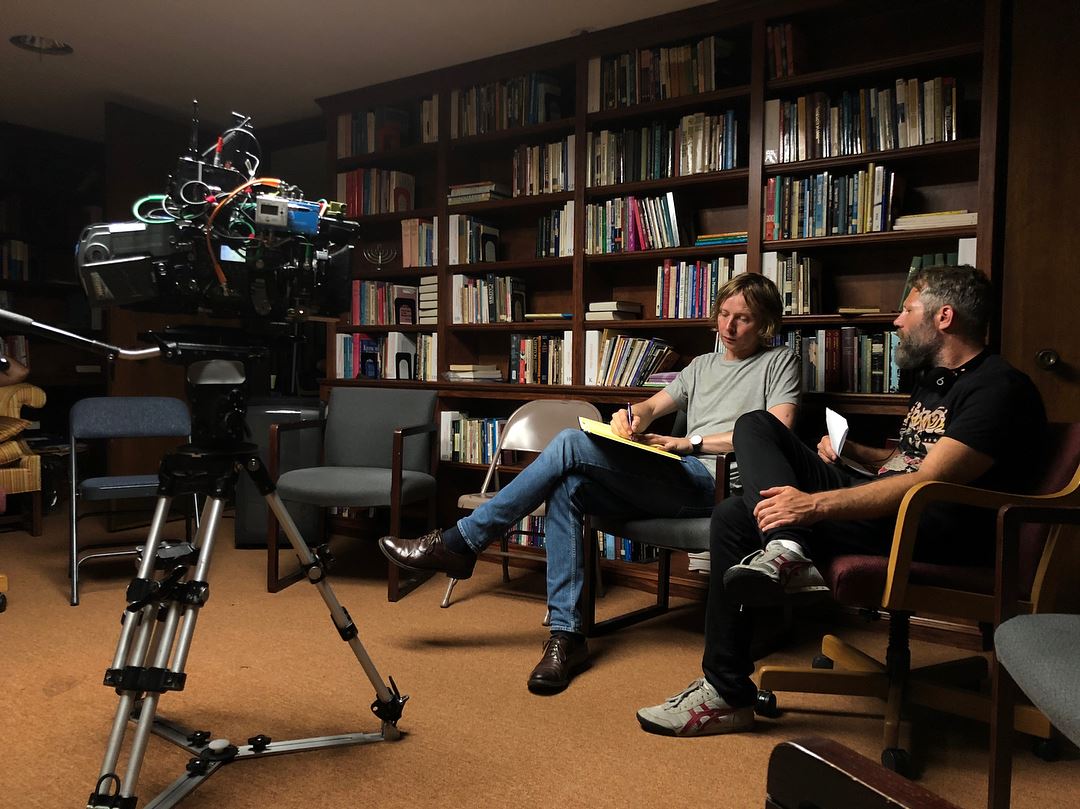
“Sound of Metal” cinematographer Daniël Bouquet with director Darius Marder on the right
Caviar LA
Dir: Darius Marder, DoP: Daniël Bouquet
Format: 2perf, 35mm Film
Camera: Aaton Penelope
Lens: Sigma Cine Lenses
Bouquet: Darius and I wanted to shoot “Sound of Metal” on film because for us it was the best recipe for our character, concentration on set and mobility. 2perf would give us enough stock, length on the roll, and the aspect ratio Darius loved from “Place Beyond the Pines.” I used the Penelope before on smaller drama and documentary in Europe and often it was such a great way to keep it compact, but still having the possibility to shoot film in pretty challenging conditions. A few rolls in a backpack and off we went. In 2perf it’s very quiet and comfortable for working from the shoulder. We worked without VTR or script supervisor. I believe Riz would have loved to see some some playback now and then, but I’m actually happy he didn’t…Because our budget was challenging I did a test with the Sigma Cine Lenses and I felt that the slightly unpolished character, size and close focus would suit our story well. We shot most of it on a 24mm and a 35mm. One to cover most of the story and the 35mm for Rubens auditive perspective.
“Tenet”
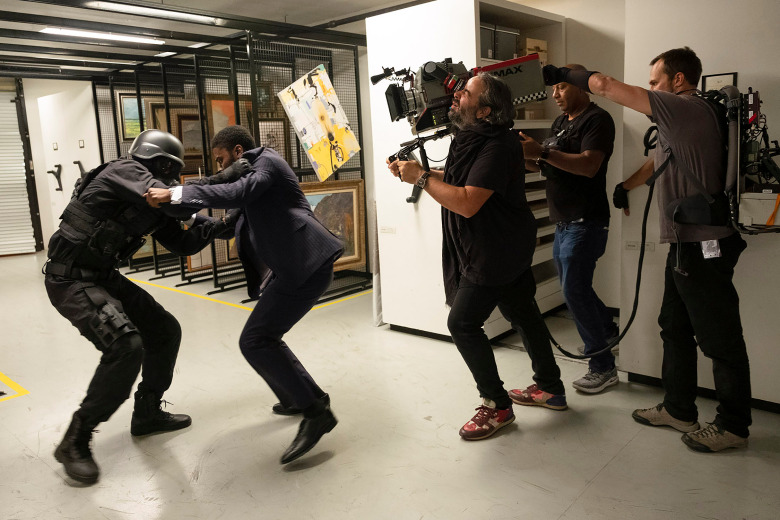
“Tenet” cinematographer Hoyte Van Hoytema (operating camera)
Melinda Sue Gordon
Dir: Christopher Nolan, DoP: Hoyte Van Hoytema
Format: Imax 15 perf and 65mm 5 perf
Camera: Imax MSM cameras, Panavision system 65 cameras, Arri 765 cameras, Logmar Magellan camera
Lens: Dan Sasaki Imax special lenses, Sphero lenses Custom, Imax 50 & 80 macro
Hoytema: The choice of format and cameras were a natural evolution of technology Chris and I are perfecting from our previous adventures. We always keep building and expanding it, to maintain and grow what’s in my opinion the most immersive and visceral format available.
“The Trial of the Chicago 7”

“The Trial of the Chicago 7” cinematographer Phedon Papamichael with director Aaron Sorkin on the right
Netflix
Dir: Aaron Sorkin, DoP: Phedon Papamichael
Format: Large Format
Camera: ARRI Alexa LF Mini
Lens: Panavision Anamorphic lenses: C-Series and T-Series – both “expanded” to cover the large format sensor (which was done for the first time on “Ford v Ferrari”), also my personal set of spherical Canon K-35, tweaked by Dan Sasaki to match the anamorphic in terms of tone and softness.
Papamichael: I don’t look for lenses that are too sharp or perfect. I usually prefer the older glass from the ’70s and early ’80s. Our objective was to find glass that covered the large format sensor of the Alexa LF, but also had a vintage quality to the era we were recreating. I felt the “expanded” Panavision C & T-series would be appropriate to represent the most interesting imperfection that anamorphic can offer, with their subtle falloff and vignetting around the edges, yet sharp in the center to draw the focus onto our characters, but without heavy distortion. The core the film is a court-room drama, which would dictate for a lot of the coverage to be done in close-ups. But since our protagonists function as a group, I didn’t want to isolate them from their surrounding, but rather capture their looks and reactions to each other’s action, which was vital for conveying their group dynamic. I wanted to connect all players in the court-room as much as possible and not have them be talking heads! Shooting large format allowed for intimacy of having the camera up close to our defendants and witnesses, with the shallower depth of field even in the wider focal lengths (40 & 50mm), yet not isolating them from their surroundings by maintaining the wider field of view.
It also aids with the dynamic sequences intercutting with our court-room setting: For the riots in the park and on the streets, it allows the audience to experience what it’s like to be in the midst of the action and brutality, yet keeps you emotionally involved with the main characters — and by the way, it helps with the actor’s performances, to be right in the midst of it all, with hand-held cameras up close, all shot on the actual locations, with no stage or green-screen work!
“The United States Vs. Billie Holiday”

“The United States Vs. Billie Holiday” cinematographer Andrew W. Dunn (operating camera)
Takashi Seida
Dir: Lee Daniels, DoP: Andrew W. Dunn
Format: 35MM Anamorphic
Camera: Panavision Panaflex, Clockwork Bolex H16
Lens: C-Series Anamorphic
Dunn: Lee Daniels and I wanted to create a look, moreso a feeling of being within Billie Holiday’s time, space and of course, her head. The look, our observational style, had to be subjective — to be there with her, not looking back, inviting our audience in. We chose to shoot on film, with tweaked anamorphic lenses. This allowed for the combination of textures, colors, and shadows we wanted. Dan Sasaki at Panavision made adjustments to our optics, to alter the curve, to make optics come alive. The combination of Kodak Film, mostly 5219, plus 7219, PV Anamorphic C-Series have the unique quality of taking us back through time, and at the same time planting us firmly in that time of Billie.
“The White Tiger”

“The White Tiger” Cinematographer Paolo Carnera
Tejinder Singh Khamkha/NETFLIX
Dir: Ramin Bahrani, DoP: Paolo Carnera
Format: 4.5K
Camera: Arri Alexa LF 4.5K., Aspect ratio 2:1
Lens: Zeiss Supreme primes and Angenieux Optimo Zooms
Carnera: In my opinion Alexa is the best camera to achieve a film look in digital cinematography. LF is a great camera which allowed us to use the beautiful Arri chip in a native 4K format, which is a Netflix requirement. Zeiss Supreme lenses are fast, and not too sharp for large format cameras, which allowed me to shoot in really low light conditions. They also have a really good way to record colors . Zeiss Supreme are flexible and light. We needed to shoot fast, and to have a light camera and lenses package for Steadycam and Handheld. That’s why I choose Alexa Mini LF and Zeiss Supreme. I needed to drive the audience through a bitter, harsh, funny, tragic and colorful story . I needed to have flexible tools to allow me suddenly to twist from a comedy story line to a tragic one, from past to present, from a poor environment to a rich one. Always leaving Ramin Baharani free to shoot fast, and with that for the actors to also themselves feel that creative freedom.
“The World to Come”

“The World To Come” Cinematographer Andre Chemetoff (with Director Mona Fastvold and crew)
courtesy of filmmaker
Dir: Mona Fastvold, DoP: Andre Chemetoff
Format: Super 16 mm
Camera: Arri 416
Lens: Zeiss master primes
Chemetoff: When I first talked to Mona she was decided on the imagery the film should depict. She shared a great amount of references including stills taken from Russian cinema and paintings from the artist Vilhelm Hammershoi. These illustrated a clear and set direction for the movie’s look. We were then able to refine this vision. We knew we had to shoot on film and somehow translate a certain softness to achieve an ethereal image.
As we wanted to shoot film and because the 35mm was not an option due to budget restrictions, we then opted for Super 16 deciding to combine it with sharp lenses, Zeiss Master Primes. Before leaving for Romania, I tested a selection of few lenses through Dior stockings in order to get that misty look.


